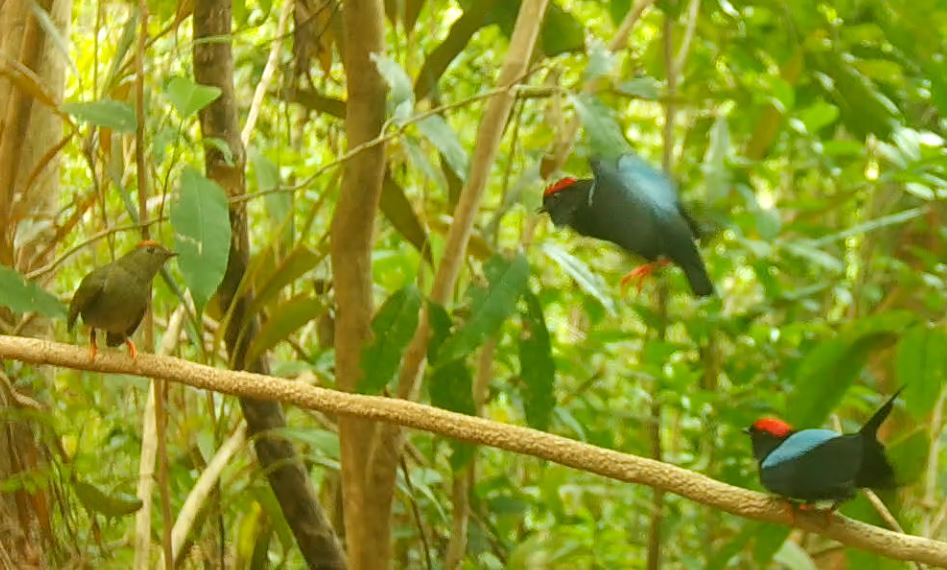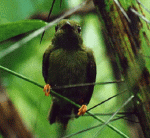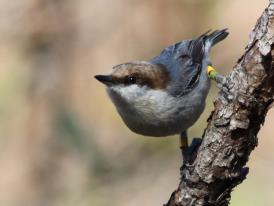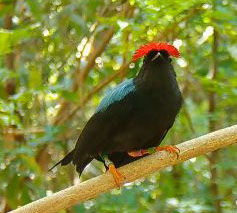Ongoing Research Projects
Ongoing Research Projects
Adaptive advantages of cooperative courtship
Causes and consequences of variation in female mate choice
Mechanisms of sexual selection
Assessing the role of social context on decisions to cooperate

Adaptive advantages of cooperative courtship
The evolution of cooperation is one of the enduring puzzles of evolutionary biology. Why do some individuals apparently sacrifice their own self-interests to help others? Cooperative mate attraction is among the most counterintuitive forms of helping behavior: in general, males are expected to compete vigorously for mates but in some species they instead form cooperative alliances and work together to attract females. Male lance-tailed manakins form long-term cooperative partnerships to court females with tightly-coordinated song and dance displays, but only the dominant male of each pair mates with the females the partners attract (DuVal 2007a).
 This picture shows the "leapfrog" courtship display of the lance-tailed manakin. A female (left) watches as the alpha and beta male leap over one another in a cooperative courtship display. At the end of this bout of leapfrog dancing, the alpha (or dominant) male gives the "eek" vocalization and leaps from the display perch, only to return a few seconds later and resume the leapfrog display with his beta partner. If the female is receptive, the beta leaves and the alpha continues to display alone and may copulate (DuVal 2007b).
This picture shows the "leapfrog" courtship display of the lance-tailed manakin. A female (left) watches as the alpha and beta male leap over one another in a cooperative courtship display. At the end of this bout of leapfrog dancing, the alpha (or dominant) male gives the "eek" vocalization and leaps from the display perch, only to return a few seconds later and resume the leapfrog display with his beta partner. If the female is receptive, the beta leaves and the alpha continues to display alone and may copulate (DuVal 2007b).
This unusual cooperative behavior raises a number of questions, including:
(1) Why do subordinate males cooperate? I found that beta behavior was best explained by long-delayed direct reproductive benefits (DuVal 2007c). Betas didn’t benefit from direct reproduction during their beta tenure, nor were they closely related to their alpha partners, but cooperation did increase betas’ chances of later becoming alphas. Interestingly, betas whose alpha partners were experimentally removed rarely held on to their new alpha status until the next breeding season, and some never even tried to take over the empty alpha slot: though being a beta helps males move up in the reproductive ranks, betas are not just waiting in line for a guaranteed alpha position.(2) Why do dominant males tolerate subordinates? Betas benefit from cooperation by increasing their chances of becoming alphas, but what do alpha males get out of this cooperative alliance?
(3) How do morphological and physiological differences affect status and reproductive success? To what extent are physical differences among individuals explained by age, and to what extent do they result from differences in individual quality? How do these differences translate into reproductive success?
References:
DuVal, E.H., C.C. Vanderbilt, and L. M'Gonigle. (2018) The spatial dynamics of female choice in an exploded lek generate benefits of aggregation for experienced males. Animal Behaviour. DOI: 10.1016/j.anbehav.2018.01.009
DuVal, E. H. (2013) Does cooperation increase helpers' later success as breeders? A test of the skills hypothesis in the cooperatively displaying lance-tailed manakin. Journal of Animal Ecology, 82, 884-893. [email ehduval-at-bio.fsu.edu to request a PDF]
DuVal, E.H. (2012) Variation in annual and lifetime reproductive success of lance-tailed manakins: experience as an alpha offsets senescence in siring success. Proceedings of the Royal Society of London Series B. 279: 1551-1559. doi: 10.1098/rspb.2011.1840 PDF, data supplement
DuVal, E. H. (2007a) Social organization and variation in cooperative alliances among male lance-tailed manakins. Animal Behaviour 73: 391-401.
DuVal, E. H. (2007b) Cooperative display and lekking behavior of the lance-tailed manakin (Chiroxiphia lanceolata). The Auk. 124 (4): 1168-1185. PDF
DuVal, E. H. (2007c) Adaptive advantages of cooperative courtship for subordinate male lance-tailed manakins. American Naturalist. 169 (4): 423-432.
![]()
Causes and consequences of variation in female mate choice
 Understanding how and why females choose the mates they do is a key part of understanding the process of sexual selection. Mate choice can be exercised by either males or females, but females' disproportionate investment in gametes and offspring care means that they are usually the choosier sex. In socially monogamous systems, the direct benefits of mate choice are fairly apparent (e.g. paternal care of young). But in lek-mating species it is less clear what females may gain by being choosy. Lek mating is an extreme form of polygyny: lekking males cluster on display grounds to display for females, and males can mate with many females. Females of lekking species “shop” with relative freedom among males on the lek to choose a mate, and leave after copulating to raise their offspring with no further aid from the male.
Understanding how and why females choose the mates they do is a key part of understanding the process of sexual selection. Mate choice can be exercised by either males or females, but females' disproportionate investment in gametes and offspring care means that they are usually the choosier sex. In socially monogamous systems, the direct benefits of mate choice are fairly apparent (e.g. paternal care of young). But in lek-mating species it is less clear what females may gain by being choosy. Lek mating is an extreme form of polygyny: lekking males cluster on display grounds to display for females, and males can mate with many females. Females of lekking species “shop” with relative freedom among males on the lek to choose a mate, and leave after copulating to raise their offspring with no further aid from the male.
This project explores (1) the adaptive basis of female mate choice in a lekking passerine bird, the lance-tailed manakin (Chiroxiphia lanceolata), and (2) how the decision-making process involved in mate assessment affects the strength and direction of sexual selection. Female lance-tailed manakins move among dispersed male territories to watch male displays, often repeatedly observing multiple males before selecting a mate. Why are females so choosy? How does mating with one male rather than another affect offspring viability, survival, and eventual reproductive success?
With Rebecca Sarell and Max Planck director Bart Kempenaers, I examined the influence of indirect genetic benefits on female mate choice by combining analyses of sire and offspring genetic variability with field studies of mating behavior and phenotype. With Cornell grad student Julian Kapoor, I developed an automated telemetry system to track female movements and identify factors influencing both female visitiation patterns and choice among visited males.
Rivers, P.R. and E.H. DuVal (2019) Multiple paternity in a lek mating system: females mate multiply when they choose inexperienced sires. Journal of Animal Ecology. 89: 1142-1152. https://doi.org/10.1111/1365-2656.13158 JAE In Focus article highlighting these results.
Jones, B.C. and E.H. DuVal. (2019) Mechanisms of social influence: a meta-analysis of the effects of social information on female mate choice decisions. Frontiers in Ecology and Evolution. 7 (390): https://doi.org/10.3389/fevo.2019.00390
E.H. DuVal and J.A. Kapoor. (2015) Causes and consequences of variation in female mate search investment in a lekking bird. Behavioral Ecology. doi:10.1093/beheco/arv110
Sardell R.J., B. Kempenaers, and E.H. DuVal. (2014) Female mating preferences and offspring survival: testing hypotheses on the genetic basis of mate choice in a wild lekking bird. Molecular Ecology. DOI: 10.1111/mec.12652. [email ehduval-at-bio.fsu.edu to request a PDF]
Sardell R.J. and E.H. DuVal. (2014) Differential allocation in a lekking bird: females lay larger eggs and are more likely to have male chicks when they mate with less related males. Proceedings of the Royal Society of London Series B, 281: 20132386. doi: 10.1098/rspb.2013.2386 [email ehduval-at-bio.fsu.edu to request a PDF]
DuVal, E. H. (2013) Female mate fidelity in a lek mating system and its implications for the evolution of cooperative lekking behavior. American Naturalist, 181, 213-222. PDF
![]()
Assessing the role of social context on decisions to cooperate
Understanding the causes and consequences of reproductive cooperation is a major goal of research in the DuVal Lab. In collaboration with Jim Cox, vertebrate ecologist at Tall Timbers Research Station, and graduate student Jess Cusick, this project investigates the effects of social context (and especially mate limitation) on cooperative beha vior in the Brown-headed Nuthatch (Sitta pusilla).
vior in the Brown-headed Nuthatch (Sitta pusilla).
Brown-headed Nuthatches are small, cavity-nesting passerines found in mature pine forests of the southeastern US, and the color-banded population at Tall Timbers offers a great opportunity to study variaition in cooperative behavior. This species is a classic "cooperative breeder," meaning that non-breeding adults often help raise others' offspring rather than breeding independently. Cooperative nuthatch groups naturally vary in helper number, helper sex, and relatedness to breeders, which lets us investigate the influence of experimental manipulations on each of these factors.
Cox, J.A., J.A. Cusick, and E.H. DuVal (2019) Experimentally manipulated adult sex ratios alter cooperative behavior in a cavity-nesting songbird. Behavioral Ecology. 30: 883-893 https://doi.org/10.1093/beheco/arz030 [editor’s choice in July-August issue; featured in Current Biology]
Cusick, J.A., M. deVilla, E.H. DuVal, and J. A. Cox. (2018) How do helpers help? Helper contributions throughout the nesting cycle in the cooperatively breeding brown- headed nuthatch. Behavioral Ecoloy and Sociobiology 72:43. https://doi.org/10.1007/s00265-018-2470-1
![]()
Mechanisms of sexual selection: male competition vs. female mate choice
 Leks are classic models for studies of sexual selection due to extreme variance in reproductive success among males, but the relative influence of intrasexual competition and female mate choice in creating this skew is debatable. We examined genetic reproductive skew and the opportunity for selection on males (I males) in a population of lance-tailed manakins (Chiroxiphia lanceolata). In this cooperatively-displaying species, males compete for alpha status and females choose mates from among dispersed alphas, allowing separate quantification of these two episodes of sexual selection on males.
Leks are classic models for studies of sexual selection due to extreme variance in reproductive success among males, but the relative influence of intrasexual competition and female mate choice in creating this skew is debatable. We examined genetic reproductive skew and the opportunity for selection on males (I males) in a population of lance-tailed manakins (Chiroxiphia lanceolata). In this cooperatively-displaying species, males compete for alpha status and females choose mates from among dispersed alphas, allowing separate quantification of these two episodes of sexual selection on males.
References:
DuVal, E. H. and B. Kempenaers. (2008) Sexual selection in a lekking bird: the relative opportunity for selection by female choice and male competition. Proceedings of the Royal Society of London Series B 275: 1995-2003. (doi: 10.1098/rspb.2008.0151) PDF
![]()